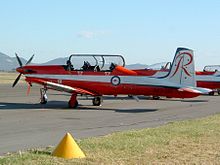Roulettes
| Roulettes | |
|---|---|

|
|
| Country: |
|
| Currently used aircraft type: | Pilatus PC-9 |
| Sponsor: | Royal Australian Air Force |
| Base airfield: | RAAF Base East Sale , Victoria |
| Founding: | 1970 |
| Colours: | Red and white |
| Weblink: | airforce.gov.au/roulettes/ |
The Roulettes are the aerobatic team of the Royal Australian Air Force (RAAF).
history
The Central Flying School formed its first official aerobatic team, the Red Sales, in 1962 with De Havilland DH.100 vampire jet aircraft, but only flew under that name for a short time. They flew for a short time under the name Telstars until the end of 1962. In 1968 they flew again for two months under the name Telstars with Aermacchi MB-326 jet trainers. The roulettes were founded in 1970 to celebrate the 50th anniversary of the RAAF and have been a permanent season ever since. First they were equipped with four maquis, then grew to five aircraft in 1974 and seven in 1981. Due to cost reductions, the team was reduced to five aircraft in 1982. Towards the end of the 1980s, the roulette had to reduce its flight hours because the MB-326 fleet developed premature fatigue problems. The Pilatus PC-9 has been used since 1989 . Currently the roulettes have seven pilots and ten technicians.
You are using six PC-9s and a spare machine.
They offer around 150 flight demonstrations a year, in Australia and in friendly countries in Southeast Asia . The roulettes are part of the RAAF Central Flying School (CFS) at RAAF Base-East Sale in Victoria . The planes are painted in red, white and blue, with a large "R" symbol on the vertical stabilizer. The RAAF uses this color scheme (minus the "R") for all of its PC-9 trainers, with the exception of the PC-9 at ARDU and FAC. This enables an aircraft to switch to or from the team in order to evenly distribute the operating hours of the aircraft fleet, since only the "R" has to be removed or painted in order to obtain a uniform team color scheme. Roulette will switch to the Pilatus PC-21 by 2019 , which was selected as the successor to the PC-9 as the advanced trainer of the RAAF as part of the AIR5428 project.
Pilots
Admission to the team is an honor for a pilot. There are seven roulette pilots. All are flight instructors, with the exception of number seven, the commander, who serves as commentator and transfer pilot for the replacement aircraft. A new team pilot begins with three months of intensive aerobatics training, starting with relatively simple maneuvers (such as loops and rolls in relays or keel line) performed at height. This is followed by more complex and demanding maneuvers (such as corkscrews, round rollers and rollbacks) up to the formations with all six aircraft in the display routines. Only when a routine is well practiced at altitude will the same maneuvers occur at the minimum safety level of 500 feet (150 m). Only season pilots fly the positions "Roulette" 2, 3 or 4, while the experienced pilots fly the positions "Roulette" 5 and 6. "Roulette" 1 is the team leader. Most members serve the team for three years before moving on to other roles.
Incidents
There have been three mid-air collisions in the history of roulette:
- In 1983, two planes collided in the air during training, killing both pilots.
- In 1988 there was another collision, with one pilot using an ejector seat to get to safety while the other landed with the landing gear retracted.
- In 2005, two more machines collided and nobody was killed.
In February 2011, an engine caught fire, whereupon the roulette was banned from flying, which was lifted after the investigation was over.
Web links
Individual evidence
- ^ History of RAAF Aerobatic Teams , accessed October 4, 2015.
- ^ Roulettes grounded after engine fire - ABC News (Australian Broadcasting Corporation), accessed October 4, 2015.

